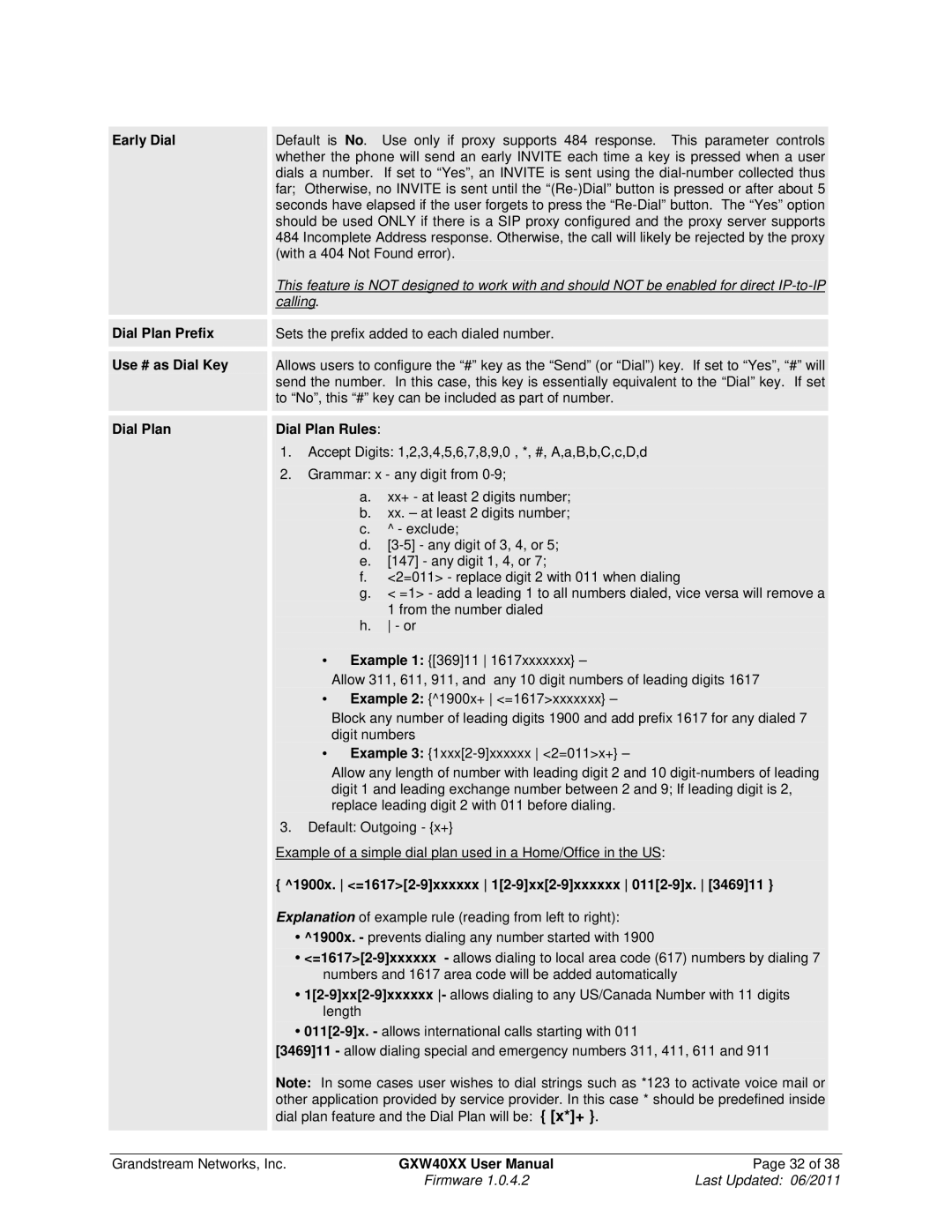
|
|
|
|
|
|
|
| Early Dial |
| Default is No. | Use only if proxy supports 484 response. This parameter controls |
|
|
|
|
|
| |||
|
|
| whether the phone will send an early INVITE each time a key is pressed when a user |
|
| |
|
|
| dials a number. If set to “Yes”, an INVITE is sent using the |
|
| |
|
|
| far; Otherwise, no INVITE is sent until the |
|
| |
|
|
| seconds have elapsed if the user forgets to press the |
|
| |
|
|
| should be used ONLY if there is a SIP proxy configured and the proxy server supports |
|
| |
|
|
| 484 Incomplete Address response. Otherwise, the call will likely be rejected by the proxy |
|
| |
|
|
| (with a 404 Not Found error). |
|
| |
|
|
| This feature is NOT designed to work with and should NOT be enabled for direct |
|
| |
|
|
| calling. |
|
|
|
|
|
|
|
|
|
|
|
|
|
|
| ||
| Dial Plan Prefix |
| Sets the prefix added to each dialed number. |
| ||
|
|
| ||||
|
|
|
|
|
|
|
|
|
|
|
| ||
| Use # as Dial Key |
| Allows users to configure the “#” key as the “Send” (or “Dial”) key. If set to “Yes”, “#” will |
|
| |
|
|
|
| |||
|
|
| send the number. In this case, this key is essentially equivalent to the “Dial” key. If set |
|
| |
|
|
| to “No”, this “#” key can be included as part of number. |
|
| |
|
|
|
|
|
|
|
|
|
|
|
|
|
|
| Dial Plan |
| Dial Plan Rules: |
|
|
|
|
|
|
|
| ||
|
|
| 1. Accept Digits: 1,2,3,4,5,6,7,8,9,0 , *, #, A,a,B,b,C,c,D,d |
|
| |
|
|
| 2. Grammar: x - any digit from |
|
| |
|
|
| a. | xx+ - at least 2 digits number; |
|
|
|
|
| b. | xx. – at least 2 digits number; |
|
|
|
|
| c. | ^ - exclude; |
|
|
|
|
| d. |
|
| |
|
|
| e. | [147] - any digit 1, 4, or 7; |
|
|
|
|
| f. | <2=011> - replace digit 2 with 011 when dialing |
|
|
|
|
| g. | < =1> - add a leading 1 to all numbers dialed, vice versa will remove a |
|
|
|
|
|
| 1 from the number dialed |
|
|
|
|
| h. | - or |
| |
•Example 1: {[369]11 1617xxxxxxx} –
Allow 311, 611, 911, and any 10 digit numbers of leading digits 1617
•Example 2: {^1900x+ <=1617>xxxxxxx} –
Block any number of leading digits 1900 and add prefix 1617 for any dialed 7 digit numbers
•Example 3:
Allow any length of number with leading digit 2 and 10
3.Default: Outgoing - {x+}
Example of a simple dial plan used in a Home/Office in the US:
{ ^1900x. <=1617>[2-9]xxxxxx 1[2-9]xx[2-9]xxxxxx 011[2-9]x. [3469]11 }
Explanation of example rule (reading from left to right):
•^1900x. - prevents dialing any number started with 1900
•
•
•
[3469]11 - allow dialing special and emergency numbers 311, 411, 611 and 911
Note: In some cases user wishes to dial strings such as *123 to activate voice mail or other application provided by service provider. In this case * should be predefined inside dial plan feature and the Dial Plan will be: { [x*]+ }.
Grandstream Networks, Inc. | GXW40XX User Manual | Page 32 of 38 |
| Firmware 1.0.4.2 | Last Updated: 06/2011 |
